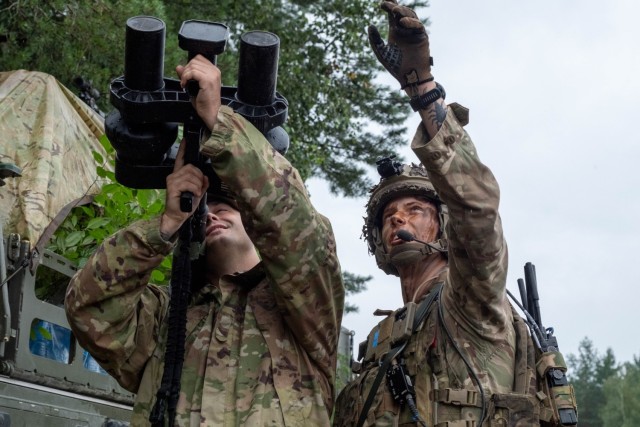
FORT BELVOIR, Va. (August 2025)— Unmanned Aerial Systems (UAS), also commonly known as drones, have significantly evolved over the last decade of large-scale combat operations—transitioning from simple reconnaissance tools to complex weapon systems.
Today’s soldiers are seeing how UAS play an increasingly pivotal and multifaceted role in contemporary conflicts and how they will serve as critical enablers to the future warfare. With UAS applications spanning precision strike capabilities, electronic warfare, and swarm tactics, their implementation can influence military operations; significantly shaping both strategic decision-making and the broader trajectory of military engagements. This makes it more imperative for Army science and technology to narrow in on this rapidly changing threat.
“The C5ISR [U.S. Army Command, Control, Communications, Computers, Cyber, Intelligence, Surveillance and Reconnaissance] Center is directly providing rapid response counter-UAS solutions to soldiers at the border, deployed worldwide, and working with different industry-provided capabilities to ensure everything is properly integrated into a common command and control (C2) architecture, which is crucial against this threat,” said Kevin White, a C5ISR Center branch chief.
The C5ISR Center possesses deep expertise in the development of compact, cost-effective, and high-performance laser protection solutions. The team has successfully transitioned numerous protection technologies to Army programs—capabilities that remain largely within the scope of government-exclusive research and development due to the absence of a commercial market.

The Center has made substantial investments in sensor protection technologies to ensure that sensors deployed on Army platforms can operate effectively in all environments. These efforts are driven by the growing global proliferation and sophistication of counter weapons systems.
A growing number of countries are actively developing C-UAS capabilities, with leading efforts underway in the United States, China, Israel, Germany, the United Kingdom, and Russia. These advancements carry significant strategic implications for a much broader global security landscape.
“Our foremost objective is to develop and deliver innovative protection technologies that significantly enhance the survivability and lethality of our UAS,” said Jason Bias, a C5ISR Center branch chief. “By equipping them with advanced, reliable, and mission-focused solutions, we aim to provide a decisive advantage on the battlefield—ensuring they are better protected, more effective, and prepared to meet the evolving demands of modern warfare.”
How will this potentially impact the C5ISR Center’s UAS programs?
One critical area will be in GPS denied arenas, where reliance on visual cues, sensors, and sophisticated sensor fusion algorithms.
If the sensors are rendered inoperable (Hard-Kill), or jammed (temporary sensor disruption), the UAS will no longer be operable. A second major area will be when Aided Target Detection and Recognition (AiTR) algorithms are utilized in UAS to enhance situational awareness, improving decision-making, and automating tasks that would otherwise require significant human effort. If they were not trained in data that is relevant to all aspects to the warfighters’ area of operations, this may significantly change the efficiency of the algorithms.
As C-UAS technologies continue to evolve and reliance on sensor-driven capabilities in UAS, intensifies, ensuring sensor survivability is critical to mission success. Continued investment in sensor protection must remain synchronized with advancements in C-UAS weapon systems; any technological gap in this area could take years to close and pose significant operational risk.
“To maintain operational superiority, we must proactively invest in technologies that protect our most critical assets,” said Bias. “Bridging the gap between evolving threats and defensive capabilities is not just strategic—it’s essential. Any delay in closing these gaps could cost us years in readiness and expose our forces to unacceptable risks.”
-----
The U.S. Army Command, Control, Communications, Computers, Cyber, Intelligence, Surveillance and Reconnaissance Center is the Army’s applied research and advanced technology development center for C5ISR capabilities. As the Army’s primary integrator of C5ISR technologies and systems, DEVCOM C5ISR Center supports our networked Warfighters by identifying, developing, maturing, and rapidly integrating innovative technologies to drive continuous transformation.
DEVCOM C5ISR Center is an asset of the U.S. Army Combat Capabilities Development Command. DEVCOM is Army Futures Command’s leader and integrator within a global ecosystem of scientific exploration and technological innovation. DEVCOM expertise spans eight major competency areas to provide integrated research, development, analysis and engineering support to the Army and DOD. From rockets to robots, drones to dozers, and aviation to artillery – DEVCOM innovation is at the core of the combat capabilities American Warfighters need to win on the battlefield of the future. For more information, visit c5isrcenter.devcom.army.mil/.


Social Sharing